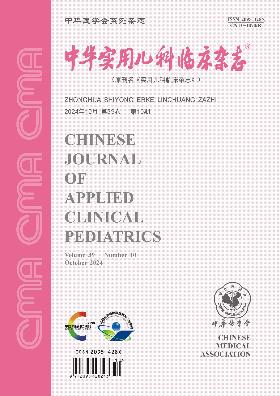儿童膜周室间隔缺损经导管闭合后三尖瓣反流的预后及危险因素
Q4 Medicine
引用次数: 0
摘要
目的探讨小儿经导管膜周室间隔缺损闭合术后三尖瓣反流的发生率、预后及反流发生或加重的危险因素。方法回顾性分析2011年1月至2017年1月在上海交通大学医学院上海儿童医学中心行经皮缝合术的1 108例患者的临床资料,分析术后三尖瓣反流加重的预后及危险因素。结果术后发生轻度三尖瓣反流24例,发生率为2.1%。5例术前有轻度及以上三尖瓣反流,术后4例反流缓解。随访期间未发生需要手术干预的严重三尖瓣反流。单因素分析显示,干预时间(P<0.05)和残留分流(P<0.05)是干预后轻度及以上三尖瓣反流发生的危险因素。二元回归分析显示,封堵器大小(mm) (OR=1.48, 95%CI: 1.13 ~ 1.90)和残留分流器(OR=6.53, 95%CI: 1.69 ~ 25.30)是干预后三尖瓣反流发生的危险因素(均P<0.05)。结论经导管封堵膜周室间隔缺损后三尖瓣反流发生率一定,但多数三尖瓣反流不需要手术干预。介入时间、闭塞器大小、分流器残留是术中、术后三尖瓣反流发生的危险因素。关键词:室间隔缺损;三尖瓣返流;鼻中隔闭塞装置;回顾性研究本文章由计算机程序翻译,如有差异,请以英文原文为准。
Prognosis and risk factors of tricuspid regurgitation after transcatheter closure of perimembranous ventricular septal defects in children
Objective
To investigate the incidence and prognosis of tricuspid regurgitation after transcatheter closure of perimembranous ventricular septal defects in pediatric patients as well as the risk factors of regurgitation occurrence or aggravation.
Methods
Clinical data of 1 108 patients who underwent percutaneous closure in Shanghai Children′s Medical Center, School of Medicine, Shanghai Jiaotong University from January 2011 to January 2017 was analyzed retrospectively, and the prognosis and risk factors of postoperative tricuspid regurgitation and aggravation were also analyzed.
Results
Mild tricuspid regurgitation occurred in 24 cases after surgery with the incidence of 2.1%.Among 5 cases with mild or above preoperative tricuspid regurgitation, the regurgitation was alleviated after surgery in 4 cases.No severe tricuspid regurgitation requiring surgical intervention occurred in any patient during follow-up.Univariate analysis showed that intervention time (P<0.05) and residual shunt (P<0.05) were risk factors for mild or above tricuspid regurgitation after intervention.Binary regression analysis indicated that the size of the occluder (mm) (OR=1.48, 95%CI: 1.13-1.90) and residual shunt (OR=6.53, 95%CI: 1.69-25.30) were risk factors for tricuspid regurgitation after intervention (all P<0.05).
Conclusions
There is a certain incidence of tricuspid regurgitation after transcatheter closure of perimembranous ventricular septal defects, but most tricuspid regurgitation do not need surgical intervention.The intervention time, size of occluder and residual shunt are risk factors of intraoperatively or postoperatively tricuspid regurgitation.
Key words:
Ventricular septal defects; Tricuspid regurgitation; Septal occlude device; Retrospective study
求助全文
通过发布文献求助,成功后即可免费获取论文全文。
去求助
来源期刊

中华实用儿科临床杂志
Medicine-Pediatrics, Perinatology and Child Health
CiteScore
0.60
自引率
0.00%
发文量
14243
期刊介绍:
Chinese Journal of Applied Clinical Pediatrics ( semi-monthly ) is a core journal of paediatrics under the supervision of China Association for Science and Technology, sponsored by Chinese Medical Association and undertaken by Xinxiang Medical College. Founded in 1986, it is openly circulated both at home and abroad. The journal has several columns, such as Expert Forum, Experimental Research and Paediatric Surgery, which are mainly for paediatric medical workers and medical researchers in hospitals. Its purpose is to reflect the new theories and technologies in paediatric medicine and scientific research at home and abroad, and to promote academic exchanges.
Chinese Journal of Applied Clinical Pediatrics is a source journal of China Science Citation Database (CSCD), a core journal of Peking University, a source journal of Chinese science and technology paper statistics (China Science and Technology Core Journals), a core academic journal of RCCSE, a high-quality scientific and technical journal of China, a high-quality scientific and technical journal of China Association for Science and Technology, and a high-quality scientific and technical journal of China Biomedical Science and Technology Association. We have been published in China Biomedical Literature Database (SinoMed), China Knowledge Network, Wanfang Data Knowledge Service Platform, China Academic Journal Abstracts, Scopus Database, Chemical Abstracts (USA), Japan Science and Technology Agency (JSTA) Database, Copernicus Abstracts (Poland), Abstracts of the Centre for Agricultural and Biological Sciences (CABS) of the United Kingdom, Cambridge Scientific Abstracts ProQuest Database, WHO Medical Journal of the Western Pacific Region (WMPR), and WHO Medical Journal of the Western Pacific Region (WMPR) of the United States. We have been included in dozens of authoritative databases at home and abroad, such as WHO Western Pacific Region Index of Medicine (WPRIM), Ullrich's Guide to Periodicals, and so on.
 求助内容:
求助内容: 应助结果提醒方式:
应助结果提醒方式:


